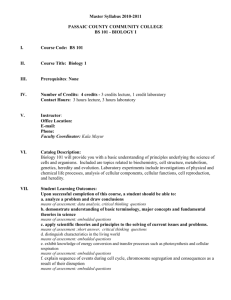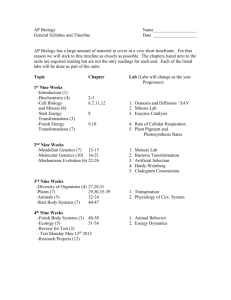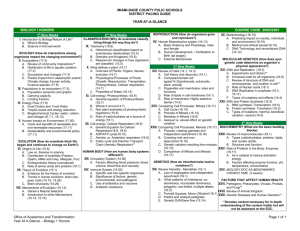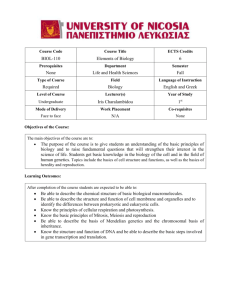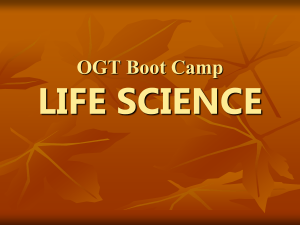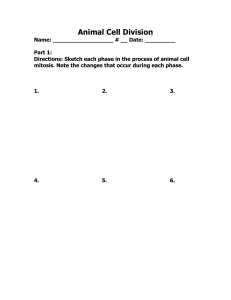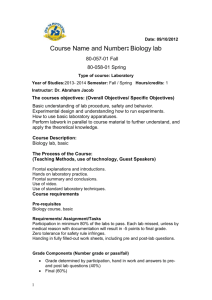General Information About the AP Biology Test
advertisement
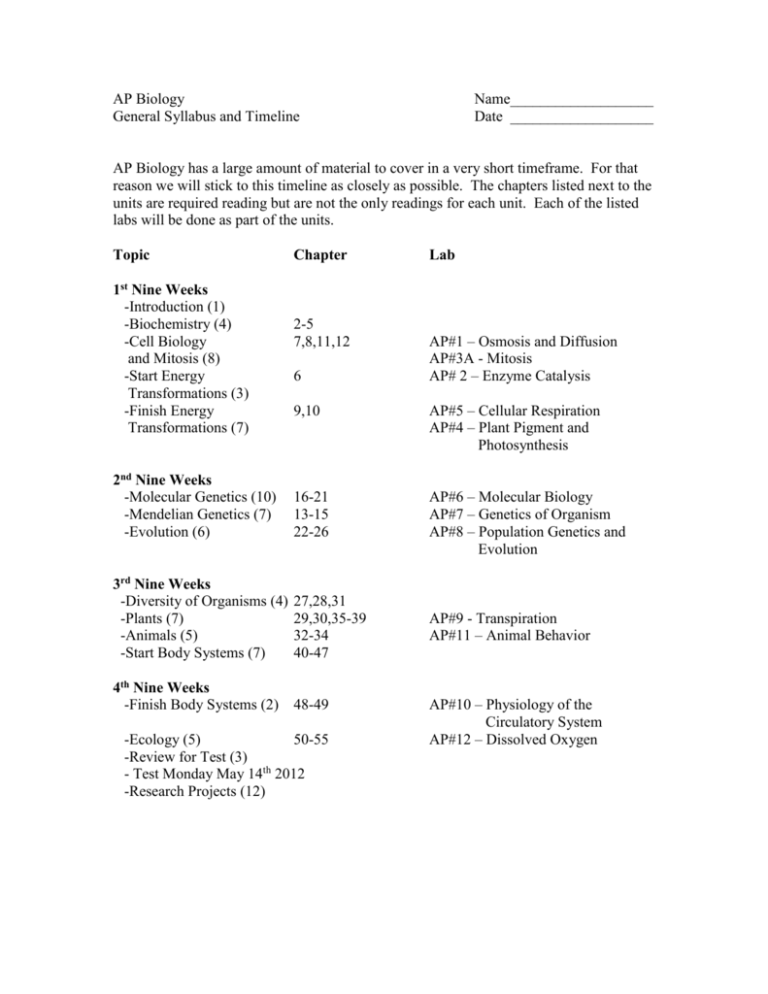
AP Biology General Syllabus and Timeline Name___________________ Date ___________________ AP Biology has a large amount of material to cover in a very short timeframe. For that reason we will stick to this timeline as closely as possible. The chapters listed next to the units are required reading but are not the only readings for each unit. Each of the listed labs will be done as part of the units. Topic 1st Nine Weeks -Introduction (1) -Biochemistry (4) -Cell Biology and Mitosis (8) -Start Energy Transformations (3) -Finish Energy Transformations (7) Chapter 2-5 7,8,11,12 6 Lab AP#1 – Osmosis and Diffusion AP#3A - Mitosis AP# 2 – Enzyme Catalysis 9,10 AP#5 – Cellular Respiration AP#4 – Plant Pigment and Photosynthesis 2nd Nine Weeks -Molecular Genetics (10) -Mendelian Genetics (7) -Evolution (6) 16-21 13-15 22-26 AP#6 – Molecular Biology AP#7 – Genetics of Organism AP#8 – Population Genetics and Evolution 3rd Nine Weeks -Diversity of Organisms (4) -Plants (7) -Animals (5) -Start Body Systems (7) 27,28,31 29,30,35-39 32-34 40-47 4th Nine Weeks -Finish Body Systems (2) 48-49 -Ecology (5) 50-55 -Review for Test (3) - Test Monday May 14th 2012 -Research Projects (12) AP#9 - Transpiration AP#11 – Animal Behavior AP#10 – Physiology of the Circulatory System AP#12 – Dissolved Oxygen Tentative First Nine Weeks Syllabus Day One - Introduction to AP Biology Chapter 1 HW: Chapter 2 and Chapter 3 Day Two - Chapter 2 Elements, Atoms and Molecules HW: Functional Group Chart and Chapter 4 Day Three - Chapter 3 and 4 Properties of Water Review F.G. Chart HW: Chapter 5 questions and Carb and Lipid Chart Day Four - Carbohydrates / Chapter 5 Lipids / Chapter 5 HW: Nucleic Acid and Protein Chart Day Five - Proteins / Chapter 5 Nucleic Acids / Chapter 5 HW: Review Sheet / Study Day Six - Biochemistry Test HW: Cell Membrane Study Guide, circle questions Day Seven - Cell Membrane Structure and Function / Chapter 8 HW: Cell Membrane Study Guide, triangle questions Day Eight - How to Grade an Essay Cell Membrane Structure and Function / Chapter 8 Lab Expectations HW: Grade 2 Essays / Read Lab / Organelle Chart Day Nine - AP Lab #1 – Osmosis and Diffusion HW: Grade 2 Essays / Organelle Chart Day Ten - Cell Structure / Chapter 7 Research Ideas HW: Chapter 12 / Lab / NaCl Essay Day Eleven - Cell Structure / Chapter 7 HW: Mitosis Sheet / Chapter 12 / Lab Day Twelve - Lab Due / Finish Organelles Mitosis / Chapter 12 HW: Read Mitosis Lab Day Thirteen - Finish Mitosis AP Lab #3A – Mitosis HW: Study / Finish Mitosis Lab Day Fourteen - Cell Biology and Division Test HW: Finish Mitosis Lab / Chapter 6 Day Fifteen - Chapter 11 Notes HW: Study for Chapter 6 and 11 Quiz Day Sixteen - Chapter 6 and 11 Quiz Pre-lab Flow Chart Day Seventeen - AP Lab #2 HW: Chapter 9 Questions and Big Sheet Day Eighteen - Chapter 9 Notes HW: Chapter 10 Questions / Lab #2 Questions / Read Lab #5 Day Nineteen - AP Lab #5 HW: Chapter 10 Questions / Lab #2 Questions Day Twenty Chapter 10 Notes (Lab #2 Questions Due) HW: Lab #5 Questions / Read Lab #4 - Day Twenty-One - AP Lab #4 (Lab #5 Questions Due) - HW: Review Sheet / Study Day Twenty-Two - Photosynthesis / Cellular Respiration Test - HW: Lab #4 Questions / Chapter 16 Questions Day Twenty-Three - Chapter 16 Notes (Lab #4 Questions Due) - HW: Chapter 17 Questions General Information About the AP Biology Test I. The exam consists of 2 parts. A. Multiple Choice 1. 100 Questions 2. 80 minutes to complete 3. 60% of overall AP score 4. You are only supposed to get about 50% correct B. Free Response 1. 4 Questions 2. 10 minute reading period and 90 minute writing period 3. 1 from molecules and cells, 1 from heredity and evolution, and 2 from organisms and populations 4. 1 will involve writing about one of the twelve labs 5. Each question is weighted equally 6. 40% of overall AP score 7. Outlines and unexplained pictures will not work! You must write in an essay form. Topic Outline Topic Percentage of Course I. Molecules and Cells 25% A. Chemistry of Life Water Organic molecules in organisms Free energy changes Enzymes 7% B. Cells Prokaryotic and eukaryotic cells Membranes Subcellular organization Cell cycle and its regulation 10% C. Cellular Energetics Coupled reactions Fermentation and cellular respiration Photosynthesis 8% II. Heredity and Evolution 25% A. Heredity Meiosis and gametogenesis Eukaryotic chromosomes Inheritance patterns 8% B. Molecular Genetics RNA and DNA structure and function Gene regulation Mutation Viral structure and replication Nucleic acid technology and applications 9% C. Evolutionary Biology Early evolution of life Evidence for evolution Mechanisms of evolution 8% III. Organisms and Populations 50% A. Diversity of Organisms Evolutionary patterns Survey of the diversity of life Phylogenetic classification Evolutionary relationships 8% B. Structure and Fuction of Plants and Animals Reproduction, growth, and development Structural, physiological, and behavioral adaptations Response to the environment 32% C. Ecology Population dynamics Communities and ecosystems Global issues 10%
